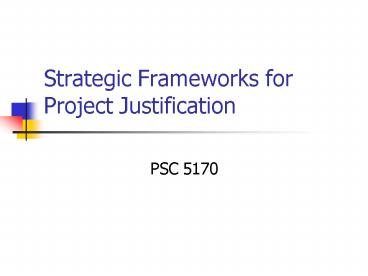Strategic Frameworks for Project Justification - PowerPoint PPT Presentation
Title:
Strategic Frameworks for Project Justification
Description:
Significantly change manner in which business supported by the system is done ... Completely changes manner in which business is done. Fewer steps, shorter ... – PowerPoint PPT presentation
Number of Views:420
Avg rating:3.0/5.0
Title: Strategic Frameworks for Project Justification
1
Strategic Frameworks for Project Justification
- PSC 5170
2
Organization Goals
- Business
- Vision
- Mission
- Objective
- Tactic
- Business Justification
- IS
- Vision
- Mission
- Objective
- Tactic
- Project Contribution
3
Roles
- Sponsor funds and champions the project in the
organization - Client reviews the project milestones and
decision points from the business point of vies - User works with the system on a regular basis
4
Strategic Information Systems
- IS that help gain strategic advantage
- Significantly change manner in which business
supported by the system is done - Outwardly aimed at direct competition
- Inwardly focus on enhancing the competitive
position - Create strategic alliances
5
Value Chain Model
- Chain of basic activities that add to firms
products or services - Primary activities
- Secondary activities
6
Value Chain
7
Value Chain Primary Activities
- Inbound
- Outbound
- Operations
- Marketing and Sales
- After-Sale Services
8
Value Chain Support Activities
- Technology development
- Procurement
- Human Resources Management
- Management Control
- accounting/finance
- coordination
- general management
- central planning
9
Porters Competitive Forces Model
The model recognizes five major forces that could
endanger a companys position in a given industry.
- The threat of entry of new competitors
- The bargaining power of suppliers
- The bargaining power of customers (buyers)
- The threat of substitute products or services
- The rivalry among existing firms in the industry
External Competitive Forces
10
(No Transcript)
11
Competitive Forces
- Threat of entry of new competition
- Bargaining power of suppliers
- Bargaining power of buyers
- Threat of substitute products or services
- Rivalry among existing firms
12
Strategies for Competitive Forces
- Note - strength of force is determined by
factors in industry - Gain a competitive edge
- Build defenses against forces
- Formulate actions to influence forces
13
Three Generic Strategies
- Cost leadership (lowest cost in industry)
- Differentiation (of products/services/quality)
- Focus (finding a specialized niche)
14
Be Low Cost Producer - IT strategic if it can
- Help reduce production costs clerical work
- Reduce inventory, accounts receivable, etc.
- Use facilities and materials better
- Offer interorganizational efficiencies
15
Produce Unique Product - IT strategic if it can
- Offer significant component of product
- Offer key aspect of value chain
- Permit product customization to meet customers
unique needs - Provide higher/unique level of customer
service/satisfaction
16
Fill Market Niche - IT strategic if it can
- Permit identification of special needs of unique
target market - Spot and respond to unusual trends
17
Strategic Questions
- Can IT create barriers to entry? (new entrants)
- Can IT build in switching costs? (buyers)
- Can IT strengthen customer relationships? (buyers)
18
Strategic Questions (cont)
- Can IT change the balance of power in supplier
relationships? (suppliers) - Can IT change the basis of competition?
(competitors) - Can IT generate new products?(competitors,
substitutes)
19
Risks of IS Success
- Change the Basis of Competition
- Lower Entry Barriers
- Promote Litigation or Regulation
- Awake Sleeping Giant
- Reflect Bad Timing
- Are Too Advanced
20
Transformational Information Systems
- Radical changes in an organizations business
processes - Radical changes in an organizations structure
- Radical changes in an industrys value streams
21
Business Process Reengineering (BPR)
- Completely changes manner in which business is
done - Fewer steps, shorter cycle times
- Complete, more expert handling of events
- Not incremental improvement
- Typically uses IT as an enabler
- Involves discontinuous thinking
22
Characteristics of BPR
- Combining jobs
- Empowering employees
- Jobs done simultaneously
- Customizing product/service
- Work performed where most logical
- Single point of customer contact
23
Transformational Information Systems
- Radical changes in an organizations structure
- reduce layers of management
- empower front-line workers
- loosely couple work units
- Radical changes in an industrys value streams
- disintermediation
- creating new markets































